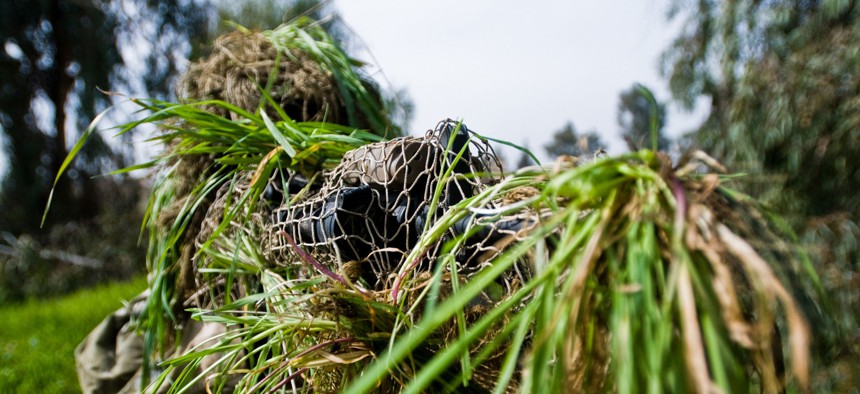
A U.S. Army sniper aims at his target during a training exercise at a Forward Observation Base in Mosul, Iraq. Photo by Army Spc. Gregory Gieske
The US Army Is Serious About Developing Invisibility Cloaks
If the U.S. Army is happy with a soldier donning a garment that makes her look like a shadow among other shadows, it might have an 'invisibility cloak' in less than two years.
Among the superpowers people want, a Harry Potter-style invisibility cloak generally comes pretty high on the list. Now even the US Army wants one for its soldiers. They are looking for companies to make them such cloaks in the next 18 months.
Scientific progress has turned many fictions into fact, but true invisibility may be unattainable, Martin Wegener of the Karlsruhe Institute of Technology in Germany told the New Scientist: “Complete invisibility of macroscopic objects for all visible colors is fundamentally impossible.”
So the army will have to settle for a more workable definition of invisibility instead—perhaps a cloak that remains invisible under certain types of light, for example, making the cloaked soldier appear to be a ghostly image.
Previous attempts at achieving invisibility have involved everything from the use of funky lenses to hidden projectors paired with cameras. But such technologies have very limited applications.
The US Army’s hope is for soldiers to able to dramatically improve their ability to camouflage themselves, in comparison to what they are able to achieve using the conventional camo-printed uniforms or even more high-tech LED light-equipped ones (paywall).
One possible avenue for workable invisibility cloaks is metamaterials, that are uniquely structured at the microscopic level. The microstructure gives the materials special properties, such as the ability to bend light around them. In this way, the cloak will seem to disappear because the reflected light will appear to come from behind the cloaked body.
Such light-bending materials were first developed almost a decade ago, but at the time could perform the magic on tiny objects only and under limited wavelengths of light. Since then the technology has improved to the extent where billion-dollar companies such as BAE systems and startups including Hyperstealth Biotechnology may be placing their bids to win the US Army’s contract.
(See also: The Army Is Testing Handheld Ray Guns)
As you would expect, the army has specifications for what its cloaks should do. They’ll need to work in all terrains, from all angles, and to perform come rain or snow. If a battery is required (which is quite likely as electricity can be used to change the microstructure of metamaterials), the army also specifies that it shouldn’t weigh more than pound and must provide at least eight hours of operation. After the first screening of prototypes, the selected entrants will be given a year to make 10 versions of their invisibility cloak for testing.
How realistic are these specifications? It really depends on the definition of invisibility. The US Army will probably have to be reasonably flexible. For instance, if the army is happy with a soldier donning a garment that makes her look like a shadow among other shadows, it might have its “invisibility cloak” quite soon.
NEXT STORY: How Blitzkrieg (Sort Of) Explains Killer Robots




